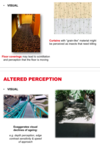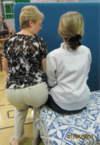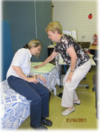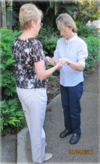L30: Managing Confusion and Dementia Flashcards
What is the definition for dementia?
Loss of diminishments of mental power due to pathological changes in the brain
- Avascular
- Neurological disease
What is confusion?
A state of being mixed up, disorientated or bewildered
What are 3 causes that can lead to delirum from confusion?
- Infection
- Hypoxia
- Underlying condition –> dementia –> delirium
What is delirium?
Rapid onset (usually hours/days) of variable and fluctuating changes in mental status (consciousness, attention, cognition and perception)
- Is a medical emergency
Is delirium treatable or untreatable?
treatable
What are the 2 presentations of confusion?
- Acute
- Chronic
What are 7 causes whihc present as delirum?
- Infection
- Eg, UTI, sepsis
- Injury/pain
- High levels of uncontrolled pain
- Blood loss
- Trauma or surgery
- Hypoxia
- Trauma or surgery
- Low blood glucose
- Uncontrolled diabetes
- Electrolytes imbalance
- Usually low K+ levels
- Drug/alcohol
- Polypharmacy
What are 6 characteristics of confusion/delirium?
- Disorientation in new environment
- Eg. older people with cognitive impairment –> who are taken out of their home (unfamilar environment) –> into hospital or aged care facility
- Inability to understand instruction (deaf, blind, aphasic)
- Language difference/problem
- Thyroid dysfunction
- Hypothyroidism
- Post-epileptic fit
- Fear, anxiety, depression
What are the 2 types of aphasia which occur after a brain injury (inability to formulate language)?
- Broca’s –> frontal lobe injury
- Werkines –> temporal lobe injury
How can the state of confusion be reversed (How long will it take to return to normal mental function?) which are implications for the physiotherapist.
Heart surgery –> severe blood loss –> confused state
- Need to get blood transfusion
What are 2 severities of confusion determines degree of patient compliance and cooperation?
- Can’t remember instructions, interpret instructions
- Unable to give informed content
- Can’t assist with goal-setting/shared decision making
Is the confusion reversible?

If confusion is irreversible, what would confusion/delirium be? What are 4 characteristics?
Dementia Progressive Element
- Strategies for assisting carer to cope
- Improve QoL for carer
- Improve QoL for patient
- Improve quality of care
If confusion is reversible, what would confusion/delirium be? What are 4 implications for management?
Implications for Management
- Strategies for assisting carer to cope
- Improve QoL for carer
- Improve QoL for patient
- Improve quality of care
What are the 8 reversible causes of delirium which follow the DELIRIUM acronym?
- Drugs, including any new medications, increased dosages, drug interactions, over-the-counter drugs, alcohol, etc.
- Electrolyte disturbances (K+ deficiency), especially dehydration, and thyroid problems
- Lack of drugs, such as when long-term sedatives (including alcohol and sleeping pills) are stopped, or when pain drugs are not being given adequately
- Conditions uncontrolled
- Infection, commonly urinary or respiratory tract infection
- Reduced sensory input, which happens when vision or hearing are poor
- Problems with visual spacio perception
- Intracranial (referring to processes within the skull) such as a brain infection, haemorrhage, stroke, or tumour (rare)
- Urinary or intestinal problems (e.g. inability to urinate, constipation)
- Brain damage
- Myocardial (heart) and lungs, e.g. heart attack, cardiac arrhythmias, worsening of chronic obstructive lung disease- Systemic problems
What are 8 ways to treat confused patients?
- Ask simple questions
- Avoid open answered questions
- Speak slowly and clearly
- Do NOT shout –> not hard of hearing; just can’t understand
- Wait for a reply.. As central processing is often very slow
- Give simple, one stahe commands 6. Reduce the number of NOISE and PEOPLE distractions in the environment- Eg. take them somewhere else
- Change focus of attention if patient becomes too agitated through inability to understand or comply
- Can be quite aggressive
- Do something else = okay
- Assessment and treatment short and relevant (eg. Rx primary problem)
- Short attention span = go for primary problem that is most concerned
- No options–> command, don’t ask (Do you want to go for a walk” “We will go for a walk”

What are the 5 types of dementia?

What are the 2/5 common dementia types?
- Alzheimers
- PD with lewy bodies
- Abnormal deposits of protein in nerve cells that regulate cognition..etc
Can have lewy body dementia + PD = can have both; can be hard to differentiate between them
What are 6 other causes of dementia?
- Multiple Sclerosis
- Huntington’s disease
- Genetic neurodegenerative disease
- Creutzfeldt-Jakob (Mad cow disease)
- Infectious disease which slowly destroys spinal cord and brain (contaminated human tissue, equipement or ingesting contaminated beef)
- Alcohol damage (Korsakoff’s)
- Neurosyphilis
- Bacteria causing infection of brain and spinal cord
- AIDS

What is Huntington’s disease?
Genetic neurodegenerative disease
What is Mad cow disease?
Infectious disease which slowly destroys spinal cord and brain (contaminated human tissue, equipement or ingesting contaminated beef)
What is neurosyphilis?
Bacteria causing infection of brain and spinal cord
What are 9 dementia presentations?
- Memory loss
- Confused
- Misunderstanding and not using words properly
- Difficulty corrdinating thought and actions
- Altered perception
- Walking and wandering
- Delusions, hallucinations (visual and auditiory), misidentification, confabulations, paranoia
- Mood and personality change
- Emotional lability
What is “memory loss” as a presentation of dementia?
- Early short-term memory is lost
- Later lose long-term memory As the disease progresses
What is “confused” as a presentation of dementia?
- Mixing up people, recognising familiar person
- Confusing place, time & objects, orientation
- E.g. thinks daughter is mother and was present at a significant life event
What is “misunderstanding and not using words properly” as a presentation of dementia?
Ask patient a question and responses with inappropriate and unrelated answer


















